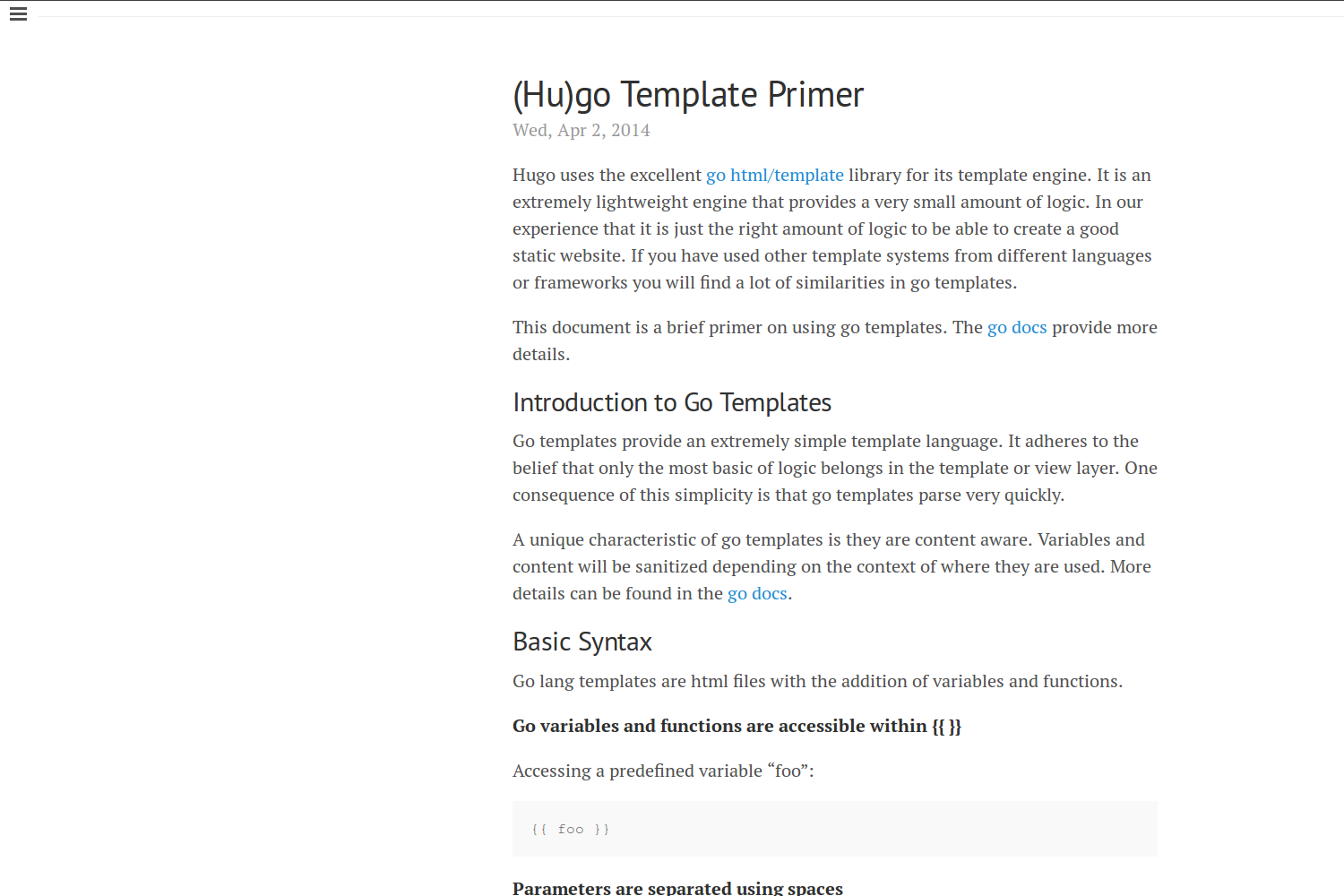Lanyon for Hugo
Lanyon is a great theme for Jekyll. This is a port of that theme, but to another static site generator, Hugo. I’m aiming to get the same look and interactions as the original Lanyon.
Hugo and Jekyll are similar in that, out of the box, you can’t make a presentable website out of them. You need some kind of theme first, or otherwise your site will be really bare-bones. If you’re a designer, you might be comfortable doing that yourself. If you aren’t, Jekyll has a thriving ecosystem of themes waiting for you. Hugo, being younger than Jekyll, does not. Lanyon-Hugo attempts to remedy that problem.
Lanyon-Hugo is a theme designed for blogging. While Hugo is flexible enough to turn almost any static content into a website, this theme is focused on blog-like use cases. Lanyon-Hugo retains the CSS, and therefore the look and feel, of the parent theme, Lanyon. This includes a sidebar that is hidden by default, and can be toggled with a button (implemented entirely in CSS). The sidebar gives some convenient navigation links, but when it is hidden, Lanyon-Hugo, just like Lanyon, is discreet and puts your content front and center.
Usage
To begin authoring content, all you have to do is clone this repository and start writing Markdown files in content/post. Front matter for Hugo can be written in JSON, YAML or TOML. I am using JSON out of preference, but it’s your content - use whatever language you want. Two example posts are already provided (lifted from the parent Lanyon, with links fixed for Hugo) as an example of the front matter you need.
Note for Jekyll users: Jekyll parses the date out of your post’s title, but Hugo does not. You must specify a date in the front matter. I specify the permalinks to look like Jekyll’s in config.json, so if you set the date correctly, the permalinks will also look correct.
Hugo’s universal config file is config.json (or YAML, or TOML). You can change the base URL of your site, the title, and the tagline from this file. The link to your GitHub repository (for whatever the site represents, say a dev blog, or a personal GitHub Page) can also be changed here. If you are familiar with Hugo, you already know that you can add more parameters to the params object to introduce more variables.
Fixed Pages
The original Lanyon had a layout for “pages”, fixed content that didn’t have a date. Lanyon-Hugo retains this concept, and refers to these pages as “fixed” (that’s the content type, if you’re familiar with Hugo concepts). Fixed pages will not display a date, only a title, and they will not be listed on the homepage of your site. Pages such as About (an example about.md has been lifted from the parent Lanyon) should generally be fixed.
You can alter the content of the custom 404 via fixed/404.md. This is useful if you want a custom 404 for your GitHub Page.
Sidebar Links
To indicate that a given piece of content should be linked in the sidebar, add a key sidebar to the front matter, and set it to true. See about.md for an example of this. You can pin content to the sidebar regardless of whether it is a post, or if it is fixed.
Sidebar content is ordered by weight, specified in the front matter. The lowest weight goes to the top and the greatest weight goes to the bottom. I’ve included an extra example file, altab.md, to demonstrate this feature. If no weight is specified in the front matter, then the weight is zero (this behavior probably comes from the zero-value of integers in Go). You can set negative weights to exploit this feature. Note that the weight must be wrapped in quotes (ie a string). Looks like Hugo converts it to an integer internally.
Note for Jekyll users: In the original Lanyon, any content that had the page layout would be added to the sidebar. However, in Lanyon-Hugo, content with the fixed type will not be added to the sidebar automatically. You must specify the sidebar flag in the front matter.
Lanyon-Hugo generates a post list at /post/. By default, Lanyon doesn’t actually have a post list, so there is no link for it anywhere in the theme. In my opinion, there are two sensible places to put it: in between the pagination buttons, and on the sidebar. You could conceivably do both. I’ve added a sidebar entry for it. If you want to add a button between the pagination buttons, take a look at my Lanyon fork; it has an example of how to do such a thing.
Look and Feel
The CSS from the original Lanyon is unchanged, and you can find it in static/css. Any of the modifications suggested for Lanyon can also be applied to Lanyon-Hugo, by changing the CSS here.
You can use syntax highlighting, if you have Pygments. See the “example content” post for an example. Lanyon has a color scheme of some kind for Pygments in css/syntax.css, but right now Hugo doesn’t know how to use it (everything will be higlighted in Monokai). When Hugo implements this feature, I will also add it to Lanyon-Hugo. More detail on Hugo’s syntax highlighting shortcode can be found here.
To Do
While Lanyon-Hugo is aiming for functional compatibility with Lanyon (ie all the old functionality is available and looks similar), there are still some things I’m missing: - pagination. Lanyon-Hugo does not have next/previous buttons (well they’re there, but as you can see, they don’t have any links). Jekyll’s pagination feature is quite good, but Hugo’s pagination is still on the roadmap for now. I may implement a hackish solution in the meantime, but ideally I’d rather wait until Hugo has a solid solution for this problem.
Contributing
If you’re interested in hacking on this theme, please check out CONTRIBUTING.
License
MIT, see LICENSE.md.
